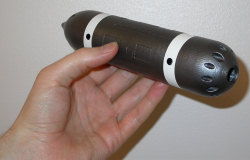
There are more than one-hundred sizable objects in our solar system, many of them with ice or liquid water, including planets, moons, asteroids, and KBOs, each reachable and explorable with present day technology
Small probes the size of a human hand or smaller could be a big help to planetary exploration. Moore’s Law and tightening budgets could team up to make that technological leap sooner rather than later. In particular, small probes packed with microelectronics and advanced software capable of learning on the alien spot might bring the deep subcyrosphere of moons like Europa or Saturn’s Dionne under scrutiny:
Space.com — The first prototypes of the DADU submersible were made of plastic from 3D printers that allowed the team to quickly “print” the digital designs into real objects. But they envision the real submersible being built from a titanium alloy in order to survive the harsh temperatures and intense pressures of underwater environments.Next up, the Swedish team hopes to further refine the miniaturized instruments. They also need to build the full integrated systems with all the miniaturized electronics before they can seriously test the submersible’s capability to survive a frigid ocean — whether on Earth or on Europa.
“I don’t think there are any particular technological breakthroughs required,” Jonsson said. “There exist possible solutions for the technological barriers; however, further developments and optimizations are required for such a mission to succeed.”
Getting down beneath the ice is still far from simple. Any Europa mission designed to penetrate the moon’s icy surface would require a mole-like drill to melt its way through the ice. The submersible would also need kilometers of tether connecting it to a surface lander or station in order to communicate with its remote human operator.
We needn’t restrict ourselves to single tiny submersibles either, small rolling, walking, and even floating probes could do the same for Mars or any other object with a solid surface we wish to explore in depth:
NASA’s Mars rover Curiosity, scheduled to reach the red planet this Sunday, is the size of an SUV for good reason: It’s built to carry 165 pounds of scientific instruments over boulders and into gullies. But putting Hummer-size robots on other planets is not altogether practical. For one, it’s expensive. (Getting a Curiosity-weight rover to Mars takes more than a million pounds of fuel.) Large rovers are also power-hungry and limited in range. For future missions, some researchers, eager to do more science with fewer resources, have begun looking to nanobots—each one about one-one-billionth as big as Curiosity.
In the end, just as computers have been greatly boosted by assembling them into networks, small unmanned devices could be released in swarms with many different abilities, all networked together and overseen by mission control back on earth. NASA’s ANTS program is studying just such a social architecture:
The Autonomous NanoTechnology Swarm (ANTS) Architecture is well suited to remote space or ground operations. It is being implemented on a near term basis, using Addressable Reconfigurable Technology (ART). In the future, Super Miniaturized ART (SMART) will form highly reconfigurable networks of struts, acting as 3D mesh or 2D fabric to perform a range of functions on demand. The ANTS approach harnesses the effective skeletal/ muscular system of the frame itself to enable amoeboid movement, effectively ‘flowing’ between morphological forms. ANTS structures would thus be capable of forming an entire mobile modular infrastructure adapted to its environment.
The ANTS architecture is inspired by the success of social insect colonies, a success based on the division of labor within the colony in two key ways: First, within their specialties, individual specialists generally outperform generalists. Second, with sufficiently efficient social interaction and coordination, the group of specialists generally outperforms the group of generalists. Thus systems designed as ANTS arebuilt from potentially very large numbers of highly autonomous, yet socially interactive, elements. The architecture is self-similar in that elements and sub-elements of the system may also be recursively structured as ANTS on scales ranging from microscopic to interplanetary distances.



I’m all for small probes, but don’t probes need to be pretty big because they have to transmit data back to Earth. Seems the need for transmitter power puts a lower limit on the size of probes.
I’m no expert on this, but I think the plan would be to have a couple of relay satellites in orbit around the celestial body under investigation that would receive the low-power signals from the little probes and then amplify them for transmission back to Earth. I don’t see how it could work otherwise.
Good article here. Shared. Cheers.
So many worlds out there I’d love us to see more of and learn more about.